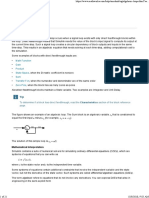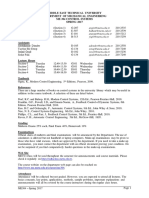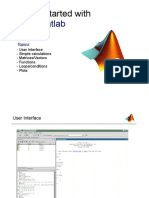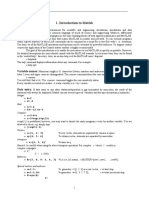Getting started with Matlab
Topics:
- User Interface - Simple calculations - Matrices/Vectors - Functions - Loops/conditions - Plots
�User Interface
�Simple alculations Using Matlab as calculator:
>> 5*2 ans = 10 >> (2+3)*5;
(Matlab uses the Variable ans to store the result of an unassigned calculation)
(A semicolon at the end of the command suppresses the output. Interally, the variable ans is set to 25.)
Defining Variables:
>> a = 3; >> b = 5; >> c = a+b;
(c = 8)
- Variables are available during your entire session and appear in the workspace - The workspace can be cleared with the command >> clear - Matlab has some pre-defined constants, e.g. pi
�Simple alculations The way in which numbers appear
The function format controls the numeric format of the dispayed values.The function affects only how numbers are displayed, not how MATLAB computes or saves them.
>> format short; >> format long; >> format rat;
5 digits (the default) 15 digits try to represent the answer as a rational number
Examples for pi :
short: long: rat:
3.1416; 3.14159265358979; 355/133;
�Simple alculations Mathematical Functions:
!rithmetic functions" + , - , * , / #$ponential functions" &rigonomertic functions" ^ , exp, log, log10 sin , cos, tan , asin, acos , atan
%ther functions" round, mod, abs, sign ...
Examples:
>> 4*x^5;
'( 4x 5 )
>> exp(3)*sin(x); '( e 3sin x ) >> mod(12,5);
'( * )
�Simple alculations
Exercise
alculate the following e$pressions"
a b b a b ca
(for a=1, b=5, c=-2)
log e
2 cos
�Simple alculations
Exercise
alculate the following e$pressions"
Solutions:
>> >> >> >> a = 1; b = 5; c = -2; b-a/(b+(b+a)/(c*a))
a b b a b ca
(for a=1, b=5, c=-2)
ans = 4.500
log e
2 cos
>> log(exp(2+cos(pi))) ans = 1
�Vectors / Matrices in Matlab
Matrices are the basic data element of Matlab (MATLAB = MATrix LABoratory)
Entering Matrices:
Separate the elements of a row with blanks or commas. Use a semicolon to indicate the end of each row. Surround the entire list of elements with square brakets [ ]
Example:
>> A = [3 2 4; 1 2 0; -2 4 3] A = 3 1 -2 2 2 4 4 0 3
�Vectors / Matrices in Matlab
Row-vectors are 1 x n matrices and column-vectors are n x 1 - matrices. row-vector
>> a = [4 -1 2] a = 4 -1 2
column-vector:
Creating Matrices from vectors:
columnvectors: >> a = [4; -1; 2]; >> b = [2; 3; -3]; >> c = [1; 2; 0]; >> C = [a b c] C = 4 -1 2 2 3 -3 1 2 0 rowvectors:
>> b= [4; -1; 2] b = 4 -1 2
>> a = [4 -1 2]; >> b = [2 3 -3]; >> c = [1 2 0]; >> D = [a; b; c] D = 4 2 1 -1 3 2 2 -3 0
Concatenation of matrices: E = [ C D; D C];
+ote" ,imensions must be consistent-
�Vectors / Matrices in Matlab
Since everything is a matrix in matlab, all scalar operations can also be applied to vectors/Matrices (as longs as the dimensions are consistent)
Examples:
>> >> >> >> A+4; sin(A); mod(A,2); mod(A,B);
Scalar opreations are applied component-wise and a matrix of same dimension is returned.
Operations which are well-defined for matrices are NOT applied component-wise
Example: Matrix- Multiplication
>> B = [1 2 1; 1 2 1; 1 2 1] >> A.*B ans = 1 2 1 4 2 4 3 0 1 >> A = [1 2 3; 2 1 0; 1 2 1]; >> A*B ans = 6 3 4 12 6 8 6 3 4
component-wise:
�Vectors / Matrices in Matlab
Various functions on matrices: A' size(A) diag(A) det(A) inv(A) lu(A) ... Transpose-operator # of rows and colums (returned in a row vector of dimension 2) diagonal of a square matrix (returned in a column vector) Determinant Matrix-Inversion LU-Decompostion of
Generating matrices: zeros(m,n) ones(m,n) eye(m) rand(m,n) magic(m) nxm-matrix with all zeros nxm-matrix with all ones mxm-identity matrix nxm-matrix with random values mxm-magic matrix
�Vectors / Matrices in Matlab
Accessing single matrix-elements:
A(i,j) A(i) Element in row i and column j of the Matrix A Usually used to get the i-th component of a vector
Accessing multiple matrix-elements:
A(:,j) A(i,:) j -th column vector of the Matrix A i -th row vector of the Matrix A
A(1:3,j) first 3 elements of j -th column vector of the Matrix A
Additional Notes: these operations can be used read AND to manipulate data. >> c = A(1,2); >> A(1,2) = -3; >> A(:,2) = []; store the element A12 in the variable c set A12 to the value -3 delete the second column of A
You can use the keyword end to access the last entry: >> A(end,2); last entry of the second column-vector
�Vectors / Matrices in Matlab
#$ercise
Prerequisite: Define the Matrix
. * !( . 4
. 0 2 /
/ 1 * .
* 2 3 *
Tasks: - Extract the upper left 3x3- submatrix of A - Compute the dot product of the main diagonal of A and the fourth column vector of A. - Define a Matrix B which arises from interchanging the 1st and the 4th row of A - Set the entire 3rd column of A to '1' - Insert the row-vector (1 2 3 4) at the bottom of A:
�Vectors / Matrices in Matlab
#$ercise
Prerequisite: Define the Matrix
. * !( . 4
. 0 2 /
/ 1 * .
* 2 3 *
Tasks: - Extract the upper left 3x3- submatrix of A - Compute the dot product of the main diagonal of A and the fourth column vector of A. - Define a Matrix B which arises from interchanging the 1st and the 4th row of A - Set the entire 3rd column of A to '1' - Insert the row-vector (1 2 3 4) at the bottom of A:
Solutions:
>> A(1:3,1:3) >> diag(A)'*A(:,4)
>> B = [A(4,:); A(2:3,:);A(1,:)]
>> A(:,3) = 1;
>> A(end+1,:) = [1 2 3 4];
�5riting Functions in Matlab
A self-defined Function is stored in a file: <functionName>.m
All .m-files in the current directory are available in your command window
�5riting Functions in Matlab Skeleton of a function:
function [ output_args ] = <functionName>( input_args ) %FUNC Summary of this function goes here % Detailed explanation goes here
Example:
Function which returns the sum of the top-left and the bottom-right element of a matrix: nonsense.m
function [ r ] = nonsense( A ) r = A(1,1) + A(end,end); end
Note: Neither the type, nor the dimensions of the parameters has to be specified
�5riting Functions in Matlab Functions with more than one Parameter:
Get the two different Products of two Matrices in one function call:
function [ AB BA ] = MatrixMult( A,B ) AB = A*B; BA = B*A; end >> A = [1 2 3; 2 3 4; 1 0 2]; >> B = [0 1 2; 2 4 1; 5 3 1]; >> [M1,M2] = MatrixMult(A,B); 9 M1= 6 18 12 14 25 5 7 12 8 M2 = 13 14 11 20 23 4 4 7
�5riting Functions in Matlab Exercise:
Write a function ld(x) which returns the logarithm of a number x to the basis 2.
�5riting Functions in Matlab Exercise:
Write a function ld(x) which returns the logarithm of a number x to the basis 2.
Solution:
function [ r ] = ld( x ) r = log(x)/log(2); end
�Loops / Loops
onditions
for i = N ... commands ... end
repeats the commands for each element of a vector N. The currently processed vector element is available inside the loop via the running parameter (here: i)
A vector with incremental elements can easily be created with the colon (:) -operator >> t = 1:10 t = 1 2 3 4
default-increment is 1
6 7
10
>> s = 2:0.2:3 s = 2.0 2.2
explicitly setting the default
2.4
2.6
2.8
3.0
�Loops /
onditions
Conditions
if (expression) ... commands ... end
If the expression is true, the commands are executed, otherwise the program continues with the next command immediately beyond the end statement
You can create alternative command sections with else and elseif: if (expression1) ... elseif (expression2) ... elseif (expression3) ... else ... end
as soon as one of the expressions is true, the respective commands are executed and the program continues beyond the end statement. The command after an else-statement are executed when none of the conditions are true.
�Loops /
onditions
Conditions
Examples for expressions:
(a < b) (a == b) (a ~= b)
True if a is less than b True if a is equal to b True if a is not equal to b
Compound statements:
(x < 3 & y < 4) (x < 3 | y < 4)
Logical AND Logical OR
�Loops / Exercise:
onditions
Write a function fact_or_sum(n) which computes i if i =1 n is even and n! if n is odd (for n>0)
n
�Loops / Exercise:
onditions
Write a function fact_or_sum(n) which computes n is even and n! if n is odd (for n>0)
i
i =1
if
Solution: function [ res ] = fact_or_sum( n )
res = 1; for i=2:n if (mod(n,2) == 1) res = res * i; else res = res + i; end end end
�Loops /
onditions
Conditional Loops
while (condition) ... commands ... end &he loop is repeated as long as the condition is satisfied
The break command
break can be used to force any loop to end;
x = 1; while (1 == 1) x = x+1; if x>10 break end ... end
�Plots
The plot function has different forms, depending on the input arguments. - If y is a vector, plot(y) produces a piecewise linear graph of the elements of y versus the index of the elements
>> y = [3 1 2 5 2 4]; >> plot(y)
Note: Graphing functions automatically open a new figure window if there are no figure windows already on the screen. If a figure window exists, it is used for graphics output.
�Plots
- If you specify two vectors as arguments, plot(x,y) produces a graph of y versus x.
>> x = [0:2:10]; >> y = [1 2 4 4.5 3 0]; >> plot(x,y)
$ 7
2 .
* /
0 0
6 083
4 /
.2 2
�Plots
Specifying line styles, colors and markers
plot(x,y,'color_style_marker') color_style_marker is a string containing from one to four characters (enclosed in single quotation marks) constructed from a color, a line style, and a marker type. The strings are composed of combinations of the following elements: olor" 'c' 'm' 'y' 'r' 'g' 'b' 'w' 'k'
cyan magenta yellow red green blue white black
Line St7le" '-' '--' ':' '.-'
solid dashed dotted dash-dot no line
Mar9er &7pe" '+' 'o' '*' 'x' 's'
plus mark unfilled circle asterisk letter x filled square no marker
888
�Plots
#$amples"
>> plot(x,y,'ks') plots blac9 s:uares at each data point; but does not connect the mar9ers with a line8 >> plot(x,y,'r:+') plots a red-dotted line and places plus signs at each data point
�Plots
Plotting multiple data sets in one graph
Multiple $-7 pairs as arguments create multiple graphs with a single call to plot >> plot(x,y,x,y2,x,y3)
Adding plots to an existing graph
if 7ou t7pe the command hold on M!&L!< does not replace the e$isting graph when 7ou issue another plotting command= it adds the new data to the current graph; rescaling the a$es if necessar78 >> >> >> >> plot(x,y); hold on plot(x2,y2); hold off
�Plots
#$ercise
reate a plot of sin'$) with .22 data points in the inter>al ?2;*
�Plots
#$ercise
reate a plot of sin'$) with .22 data points in the inter>al ?2;*
Solution:
>> s = 2*pi/99; >> x = 0:s:2*pi; >> y = sin(x); >> plot(x,y,'r:+')
























































































